|






















|
|
|
In this page we look at the basics of air conditioning in the
Scorpio fitted with manual A/C or the more sophisticated
Climate Control.

Lets first look some principles of operation
Latent Heat
When a liquid boils (converts to gas) it absorbs heat without raising the
temperature of the resulting gas. When the gas condenses (converts back to a
liquid), it gives off heat without lowering the temperature of the resulting
liquid. This is called Latent Heat.
Relative Humidity
The amount of moisture (water vapour content) that the air can hold is
directly related to the air temperature. The more heat there is in the air, the
more moisture the air can hold. The lower the moisture content in the air, the
more comfortable you feel. Removing the moisture from the air lowers its
relative humidity and improves personal comfort.
Effects of Pressure on Boiling or Condensation
As the pressure is increased on a liquid, the temperature at which the
liquid boils (converts to gas) also increases. Conversely, when the pressure on
a liquid is reduced, its boiling point is also reduced. When in the gas state,
an increase in pressure causes an increase in temperature, while a decrease in
pressure will decrease the temperature of the gas.
|
Air conditioning is the process by which air is cooled and
dehumidified. The air conditioning in your car, your home and your office all
work the same way. Even your refrigerator is, in effect, an air conditioner.
While there are many physical principles that relate to air conditioning, this
article sticks to the basics. It explains the general concepts of automotive air
conditioning, the components used and what you need to know to keep your car's
A/C system working properly.
 |
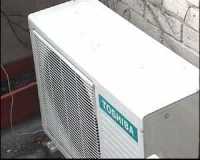 |
| Office A/C Internal Unit |
Office A/C external Unit |
Basically, air conditioning systems operate on the principles of
evaporation and condensation.
Here's a simple example of evaporation. Imagine that you're swimming around in
your neighbour's backyard pool on a summer day. As soon as you get out, you
start to feel cooler. Why? The water on your body starts to evaporate and turns
into water vapour. And as it evaporates, it draws heat away from your body, and
you get goose bumps. Brrr! Now let's say your neighbour hands you a big glass of
ice-cold lemonade. You take a sip and set it down on a table. After a minute or
two, you notice that water has collected on the outside of the glass. This is
condensation. The air surrounding the glass becomes cooler when it encounters
the cold glass, and the water vapour the air is carrying condenses into water.
Both of these examples occur at normal atmospheric pressure. But higher
pressures can also change a vapour (or a gas) into a liquid. For example, if you
look at a typical butane cigarette lighter, you can see liquid inside it. But as
soon as you push down on the button, butane gas comes out. Why? The butane is
under high pressure inside the cigarette lighter. This high pressure causes the
butane to take liquid form. As soon as the butane is released and it encounters
normal atmospheric pressure, it turns back into a gas. Now hold the lighter as
you release the gas and feel it get cold - that is because as the liquid turns
to gas it requires latent heat and it draws this heat out of you hand and the
environment making it feel cold.
The reverse is true too - latent heat is given up when gas is compressed into
a liquid.. Hold a bicycle pump in your hands after inflating a tyre an feel how
hot it is. Although you can not compress the air enough to become a liquid you
can feel the released latent heat being given up into your hand.
OK, those are the basic ideas. But how do they apply to making your car's vents
blow cool air? The principles of evaporation and condensation are utilized in
your car's A/C system by a series of components that are connected by tubing and
hoses. There are six basic components: the compressor, condenser,
receiver-drier, thermostatic expansion valve, the evaporator and the life-blood
of the A/C system, the refrigerant.
Refrigerant is a liquid capable of vaporizing at a low temperature. In the past,
R-12 refrigerant was used in cars. But this chlorofluorocarbon (CFC) is said to
be harmful to the earth's ozone layer. Consequently, all vehicles built after
1996 use R-134A, a more environmentally friendly refrigerant. In the case of the
Scorpio all the new range had R134a from the start. The refrigerant differs from
R12 in that it is about 10% less efficient in cooling and has smaller molecules.
Here's how an air conditioning system and its components work.
Step One: The compressor is the power unit of the A/C system. It is
powered by a drive belt connected to the engine's crankshaft. On the Scorpio you
can see it on the right hand side of the engine bay and although the drive belt
is permanently rotating the front pulley, the pulley is connected to the
compressor by a magnetic clutch. So it spins freely with the clutch disengaged
and drives the compressor when engaged. When the A/C system is turned on, the
compressor 'compresses' the refrigerant vapour heating it up and pumps it under
high pressure to the condenser.
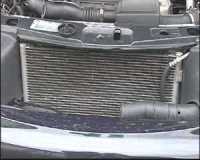 |
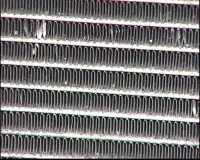 |
| Scorpio Condenser |
Fins increase surface
area |
Step Two: The condenser is a device used to change the high-pressure
refrigerant vapour to a liquid. It is mounted ahead of the engine's radiator,
and it looks very similar to a radiator with its parallel tubing and tiny
cooling fins. If you look through the grille of a car and see what you think is
a radiator, it is most likely the condenser. The hot vapour from the compressor
arrives and the fins help the air flowing through the condenser remove heat from
the refrigerant, changing it to a much cooler liquid state. When the car is
stationary the radiator cooling fans perform the task of moving air through the
condenser.
 |
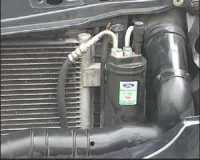 |
| Protective cover held
with screws |
Receiver Dryer |
Step Three: Refrigerant moves to the receiver-drier. This is the
storage tank for the liquid refrigerant. It also removes moisture from the
refrigerant. Moisture in the system can freeze and then act similarly to
cholesterol in the human blood stream, causing blockage. The receiver-drier is
used on the high side of the Scorpio system and uses a thermal expansion valve.
This type of metering valve requires liquid refrigerant. To ensure that the
valve gets liquid refrigerant, a receiver is used. The primary function of the
receiver-drier is to separate gas and liquid. The secondary purpose is to remove
moisture and filter out dirt.
 |
| Expansion Valve |
Step Four: As the compressor continues to pressurize the system, cool
liquid refrigerant under high pressure is circulated from the receiver-drier to
the thermostatic expansion valve. The valve relieves pressure from the liquid
refrigerant so that it can expand and become refrigerant vapour in the
evaporator. Remember that when a liquid becomes a gas it needs latent heat and
so it extracts this from its surroundings cooling them down. The expansion valve
is the "brain" of the system. By sensing the temperature of the evaporator, or
cooling coil, it allows liquid to pass through a very small orifice, which
causes the refrigerant to expand to a low-pressure, low-temperature gas. This
"cold" refrigerant flows to the evaporator
 |
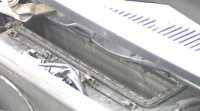 |
 |
| Evaporator with Filters |
Filters removed |
Pollen Filters |
Step Five: The evaporator is very similar to the condenser. It
consists of tubes and fins and is mounted inside the passenger compartment. As
the cold low-pressure refrigerant is released into the evaporator, it vaporizes
and absorbs heat from the air in the passenger compartment. As the heat is
absorbed, cool air will be available for the occupants of the vehicle. A blower
fan inside the passenger compartment helps to distribute the cooler air. The
evaporator serves as the heat absorption component. The evaporator provides
several functions. Its primary duty is to remove heat from the inside of your
vehicle. A secondary benefit is dehumidification. As warmer air travels through
the aluminium fins of the cooler evaporator coil, the moisture contained in the
air condenses on its surface. Dust and pollen passing through stick to its wet
surfaces and drain off to the outside. On humid days you may have seen this as
water dripping from the bottom of your vehicle. Rest assured this is perfectly
normal.
The ideal temperature of the evaporator is 32° Fahrenheit or 0° Celsius.
Refrigerant enters the bottom of the evaporator as a low pressure liquid. The
reducing pressure and the warm air passing through the evaporator fins causes
the refrigerant to boil (refrigerants have very low boiling points). As the
refrigerant begins to boil, it absorbs large amounts of heat from the air
entering the passenger compartment and this heat is then carried away with the
refrigerant. Several other components work in conjunction with the evaporator.
As mentioned above, the ideal temperature for an evaporator coil is 0
centigrade. Temperature and pressure regulating devices must be used to control
its temperature. In the Scorpio the de-ice switch has a temperature probe
mounted on the evaporator and cycles the compressor off when near to freezing to
prevent the evaporator from freezing up. A frozen evaporator coil will not
absorb as much heat.
Step Six: The heat-laden, low-pressure refrigerant vapour is then drawn
into the compressor to start another refrigeration cycle.
As you can see, the process is pretty simple. Just about every vehicle's A/C
system works this way, though certain vehicles might vary by the exact type of
components they have.
The best thing about air conditioning is that all you have to do is press a
button to make it work. Air conditioning systems are pretty reliable. On a
modern and relatively new vehicle, it is rare to have problems. And if there are
problems, they are pretty much one of two things: No cool air or insufficient
cool air. If you own an older car and its A/C system doesn't seem to be working
properly, here are some general troubleshooting tips:
|
No Cool Air
 | Loose or broken drive belt |
 | Inoperative compressor or slipping compressor clutch |
 | Defective expansion valve |
 | Clogged expansion valve, receiver-drier or liquid refrigerant line |
 | Blown fuse |
 | Leaking component: any of the parts listed above or one of the A/C lines,
hoses or seals |
Insufficient Cool Air
 | Low refrigerant charge |
 | Loose drive belt |
 | Slipping compressor clutch |
 | Clogged condenser |
 | Clogged evaporator |
 | Slow leak in system |
 | Partially clogged filter or expansion valve |
|
Most A/C repairs are best left to a specialist repairer or
garage. Recharging the refrigerant, in particular, requires special equipment
that most people don't own. There are a couple things you can do, however.
First, make sure to have the system checked regularly according to your
vehicle's owner's manual - in the Scorpios case that's every 10,000 miles.
Second, if you live in a place with a cold climate, it might not make much sense
to run the A/C during the winter months, but many A/C technicians recommend
running your A/C system regularly, because it contains a light mineral oil in
the refrigerant to keep the compressor properly lubricated. The general rule of
thumb is 10 minutes per month. The Scorpio heating, ventilation and air
conditioning systems also engage the A/C compressor when the distribution
control is in defrost mode.
So those are the basics behind air conditioning. The next time you're riding
along in your Scorpio and you hit the A/C button, you can say, Boy, those
evaporator tubes sure are cold. It's all thanks to R-134A!
|
Pete C |
|

